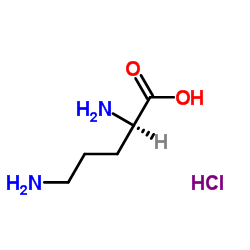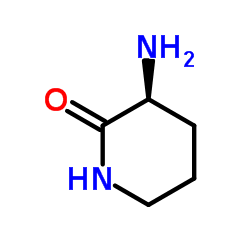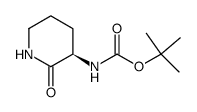D-Ornithine monohydrochloride

D-Ornithine monohydrochloride structure
|
Common Name | D-Ornithine monohydrochloride | ||
|---|---|---|---|---|
| CAS Number | 16682-12-5 | Molecular Weight | 168.622 | |
| Density | 1.165g/cm3 | Boiling Point | 308.7ºC at 760mmHg | |
| Molecular Formula | C5H13ClN2O2 | Melting Point | 239ºC (dec.)(lit.) | |
| MSDS | Chinese USA | Flash Point | 140.5ºC | |
| Name | D-Ornithine monohydrochloride |
|---|---|
| Synonym | More Synonyms |
| Density | 1.165g/cm3 |
|---|---|
| Boiling Point | 308.7ºC at 760mmHg |
| Melting Point | 239ºC (dec.)(lit.) |
| Molecular Formula | C5H13ClN2O2 |
| Molecular Weight | 168.622 |
| Flash Point | 140.5ºC |
| Exact Mass | 168.066559 |
| PSA | 89.34000 |
| LogP | 1.33980 |
| Vapour Pressure | 0.00015mmHg at 25°C |
| Storage condition | Store at RT. |
Synonym:D-(-)-2,5-Diaminopentanoic acid hydrochloride; D-(-)-2,5-Diaminopentanoic acid; D-Ornithine, monohydrochlorid Section 2 - COMPOSITION, INFORMATION ON INGREDIENTS
Risk Phrases: None Listed. Section 3 - HAZARDS IDENTIFICATION EMERGENCY OVERVIEW
The toxicological properties of this material have not been fully investigated. Potential Health Effects Eye: May cause eye irritation. Skin: May cause skin irritation. Ingestion: May cause irritation of the digestive tract. The toxicological properties of this substance have not been fully investigated. Inhalation: May cause respiratory tract irritation. The toxicological properties of this substance have not been fully investigated. Chronic: No information found. Section 4 - FIRST AID MEASURES Eyes: Immediately flush eyes with plenty of water for at least 15 minutes, occasionally lifting the upper and lower eyelids. Get medical aid. Skin: Get medical aid. Flush skin with plenty of water for at least 15 minutes while removing contaminated clothing and shoes. Wash clothing before reuse. Ingestion: Never give anything by mouth to an unconscious person. Get medical aid. Do NOT induce vomiting. If conscious and alert, rinse mouth and drink 2-4 cupfuls of milk or water. Inhalation: Remove from exposure and move to fresh air immediately. If not breathing, give artificial respiration. If breathing is difficult, give oxygen. Get medical aid. Notes to Physician: Section 5 - FIRE FIGHTING MEASURES General Information: As in any fire, wear a self-contained breathing apparatus in pressure-demand, MSHA/NIOSH (approved or equivalent), and full protective gear. During a fire, irritating and highly toxic gases may be generated by thermal decomposition or combustion. Extinguishing Media: Use water spray, dry chemical, carbon dioxide, or appropriate foam. Section 6 - ACCIDENTAL RELEASE MEASURES General Information: Use proper personal protective equipment as indicated in Section 8. Spills/Leaks: Sweep up, then place into a suitable container for disposal. Avoid generating dusty conditions. Provide ventilation. Section 7 - HANDLING and STORAGE Handling: Wash thoroughly after handling. Remove contaminated clothing and wash before reuse. Use with adequate ventilation. Minimize dust generation and accumulation. Avoid contact with eyes, skin, and clothing. Avoid ingestion and inhalation. Storage: Store in a tightly closed container. Store in a cool, dry, well-ventilated area away from incompatible substances. Section 8 - EXPOSURE CONTROLS, PERSONAL PROTECTION Engineering Controls: Facilities storing or utilizing this material should be equipped with an eyewash facility and a safety shower. Use adequate ventilation to keep airborne concentrations low. Exposure Limits CAS# 16682-12-5: Personal Protective Equipment Eyes: Wear appropriate protective eyeglasses or chemical safety goggles as described by OSHA's eye and face protection regulations in 29 CFR 1910.133 or European Standard EN166. Skin: Wear appropriate protective gloves to prevent skin exposure. Clothing: Wear appropriate protective clothing to prevent skin exposure. Respirators: A respiratory protection program that meets OSHA's 29 CFR 1910.134 and ANSI Z88.2 requirements or European Standard EN 149 must be followed whenever workplace conditions warrant respirator use. Section 9 - PHYSICAL AND CHEMICAL PROPERTIES Physical State: Powder Color: white Odor: None reported. pH: Not available. Vapor Pressure: Not available. Viscosity: Not available. Boiling Point: Not available. Freezing/Melting Point: 239 deg C Autoignition Temperature: Not applicable. Flash Point: Not applicable. Explosion Limits, lower: Not available. Explosion Limits, upper: Not available. Decomposition Temperature: > 239 deg C Solubility in water: soluble in water Specific Gravity/Density: Not available. Molecular Formula: C5H12N2O2.HCl Molecular Weight: 168.62 Section 10 - STABILITY AND REACTIVITY Chemical Stability: Stable under normal temperatures and pressures. Conditions to Avoid: Incompatible materials, dust generation, strong oxidants. Incompatibilities with Other Materials: Oxidizing agents. Hazardous Decomposition Products: Hydrogen chloride, nitrogen oxides, carbon monoxide, irritating and toxic fumes and gases, carbon dioxide, nitrogen. Hazardous Polymerization: Has not been reported. Section 11 - TOXICOLOGICAL INFORMATION RTECS#: CAS# 16682-12-5 unlisted. LD50/LC50: Not available. Carcinogenicity: D-(-)-Ornithine hydrochloride - Not listed by ACGIH, IARC, or NTP. Section 12 - ECOLOGICAL INFORMATION Section 13 - DISPOSAL CONSIDERATIONS Dispose of in a manner consistent with federal, state, and local regulations. Section 14 - TRANSPORT INFORMATION IATA Not regulated as a hazardous material. IMO Not regulated as a hazardous material. RID/ADR Not regulated as a hazardous material. Section 15 - REGULATORY INFORMATION European/International Regulations European Labeling in Accordance with EC Directives Hazard Symbols: Not available. Risk Phrases: Safety Phrases: S 24/25 Avoid contact with skin and eyes. WGK (Water Danger/Protection) CAS# 16682-12-5: 0 Canada None of the chemicals in this product are listed on the DSL/NDSL list. CAS# 16682-12-5 is not listed on Canada's Ingredient Disclosure List. US FEDERAL TSCA CAS# 16682-12-5 is not listed on the TSCA inventory. It is for research and development use only. SECTION 16 - ADDITIONAL INFORMATION N/A |
| Personal Protective Equipment | Eyeshields;Gloves;type N95 (US);type P1 (EN143) respirator filter |
|---|---|
| RIDADR | NONH for all modes of transport |
| WGK Germany | 3 |
| HS Code | 2922499990 |
| HS Code | 2922499990 |
|---|---|
| Summary | HS:2922499990 other amino-acids, other than those containing more than one kind of oxygen function, and their esters; salts thereof VAT:17.0% Tax rebate rate:9.0% Supervision conditions:AB(certificate of inspection for goods inward,certificate of inspection for goods outward) MFN tariff:6.5% General tariff:30.0% |
|
Increased ornithine-derived polyamines cause airway hyperresponsiveness in a mouse model of asthma.
Am. J. Respir. Cell. Mol. Biol. 48(6) , 694-702, (2013) Up-regulation of arginase contributes to airways hyperresponsiveness (AHR) in asthma by reducing L-arginine bioavailability for the nitric oxide (NO) synthase isozymes. The product of arginase activit... |
|
|
Microbacterium kyungheense sp. nov. and Microbacterium jejuense sp. nov., isolated from salty soil.
Int. J. Syst. Evol. Microbiol. 64(Pt 7) , 2267-73, (2014) Two novel strains, THG-C26(T) and THG-C31(T), were characterized using a polyphasic approach to determine their taxonomic positions. These two isolates were aerobic, Gram-stain-positive, non-motile, n... |
|
|
Influence of environmental hypertonicity on the induction of ureogenesis and amino acid metabolism in air-breathing walking catfish (Clarias batrachus, Bloch).
Indian J. Exp. Biol. 52(7) , 728-38, (2014) Effect of environmental hypertonicity, due to exposure to 300 mM mannitol solution for 7 days, on the induction of ureogenesis and also on amino acid metabolism was studied in the air-breathing walkin... |
| L-Ornithine, monohydrochloride |
| D-Ornithine hydrochloride (1:1) |
| D-Ornithine monohydrochloride |
| L-Ornithine hydrochloride (1:1) |
| (2S)-2,5-diaminopentanoic acid hydrochloride |
| D-Ornithine, hydrochloride (1:1) |
| Z3YZVQ &&L or S Form HCl |
| (S)-(+)-2,5-Diaminopentanoic acid hydrochloride |
| (2R)-2,5-diaminopentanoic acid,hydrochloride |
| L-Ornithine, hydrochloride (1:1) |
| EINECS 240-729-3 |
| D-Ornithine hydrochloride |
| (S)-2,5-Diaminopentanoic acid monohydrochloride |
| MFCD00012917 |
| L-ornithine hydrochloride |
| H-D-Orn-OH.HCl |
| L-Ornithine L-Aspartate Impurity 3 |
 CAS#:31967-09-6
CAS#:31967-09-6 CAS#:34294-79-6
CAS#:34294-79-6 CAS#:54012-73-6
CAS#:54012-73-6 CAS#:16937-91-0
CAS#:16937-91-0 CAS#:221874-51-7
CAS#:221874-51-7 CAS#:2614-06-4
CAS#:2614-06-4
